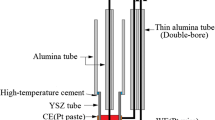Abstract
Solid-state electrochemical cells have been prepared by co-sintering pre-reacted electrode and electrolyte materials together. The electrodes investigated were the non-stoichiometric oxides of the general formula (U, M)O2±x (M = Sc, Y) and the electrolyte used was yttria-stabilized zirconia. The specimens were characterized by X-ray diffraction, Rutherford back-scattering spectrometry, scanning electron microscopy with energy-dispersive analysis by X-rays, and optical microscopy. For M = Sc, an intermediate phase is formed at the interface and is responsible for the strong bonding of the electrode layer to the electrolyte. The thickness of the intermediate layer was about 2 to 3Μm. Considerable loss of uranium, which in some cases led to destabilization of the fluorite phase, was observed from the surface of the uraniascandia electrode layers. The intermediate phase is thought to be formed as a result of reaction between the electrolyte and volatile uranium-containing species produced by decomposition of the urania-scandia electrode material. For M = Y, no evidence for the formation of such a phase was found and the adhesion of the electrode to electrolyte was poor.
Similar content being viewed by others
References
H. Obayashi andT. Kudo, “Solid State Chemistry of Energy Conversion and Storage”, edited by J. B. Goodenough and M. S. Whittingham (American Chemical Society, Washington, DC, 1977) p. 316.
Proceedings of Workshop on High Temperature Solid Oxide Fuel Cells, edited by H. S. Isaacs, S. Srinivasan and I. L. Harry (US Department of Energy, BNL 50756/TID-4500, 1977).
S. P. S. Badwal,J. Electroanal. Chem. 146 (1983) 425.
Idem, ibid. 161 (1984) 75.
S. P. S. Badwal, M. J. Bannister andM. J. Murray,ibid. 168 (1984) 363.
S. P. S. Badwal andF. T. Ciacchi,J. Appl. Electrochem. 16 (1986) 28.
W. K. Chu, J. W. Mayer andM.-A. Nicolet, “Backscattering Spectrometry” (Academic Press, New York, 1978).
C. Keller, U. Berndt, M. Debbabi andH. Engerer,J. Nucl. Mater. 42 (1972) 23.
S. P. S. Badwal, PhD thesis, Flinders University of South Australia (1977).
J. H. Handwork, G. D. White andD. C. Hill,J. Amer. Ceram. Soc. 46 (1963) 29.
A. N. Belov, S. I. Lopatin, G. A. Semenov andI. V. Vinokurov,Russ. J. Inorg. Chem. 20 (1984) 384.
E. A. Aitken andR. A. Joseph,J. Phys. Chem. 70 (1966) 1090.
W. B. Wilson, C. A. Alexander andA. F. Gerds,J. Inorg. Nucl. Chem. 20 (1961) 242.
S. P. S. Badwal, F. T. Ciacchi andD. K. Sood,Solid State Ionics 18/19 (1986) 1033.
Author information
Authors and Affiliations
Rights and permissions
About this article
Cite this article
Badwal, S.P.S., Ciacchi, F.T. & Sood, D.K. Characterization of the interface between (U, M)O2±x and yttria-zirconia. J Mater Sci 21, 4035–4042 (1986). https://doi.org/10.1007/BF00553465
Received:
Accepted:
Issue Date:
DOI: https://doi.org/10.1007/BF00553465




